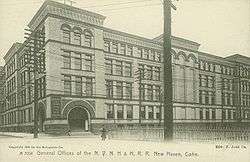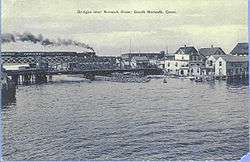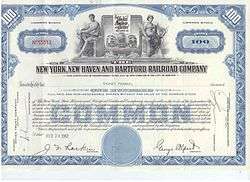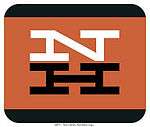New York, New Haven and Hartford Railroad
 | |
|
NH system map | |
| Reporting mark | NH |
|---|---|
| Locale |
Connecticut Massachusetts New York Rhode Island |
| Dates of operation | 1872–1968 |
| Successor | Penn Central Transportation Company |
| Track gauge | 4 ft 8 1⁄2 in (1,435 mm) standard gauge |
| Length | 2,133 miles (3,433 kilometres) |
| Headquarters | New Haven, Connecticut |
The New York, New Haven and Hartford Railroad (reporting mark NH), commonly known as the New Haven, was a railroad that operated in New England from 1872 to 1968, dominating the region's rail traffic for the first half of the 20th century.
Beginning in the 1890s and accelerating in 1903, New York banker J. P. Morgan sought to monopolize New England transportation by arranging the NH's acquisition of 50 companies, including other railroads and steamship lines, and building a network of electrified trolley lines that provided interurban transportation for all of southern New England. By 1912, the New Haven operated more than 2,000 miles (3,200 km) of track, with 120,000 employees, and practically monopolized traffic in a wide swath from Boston to New York City.
This quest for monopoly angered Progressive Era reformers, alienated public opinion, resulted in high prices for acquisitions, and increased construction costs. Debt soared from $14 million in 1903 to $242 million in 1913, even as the advent of automobiles, trucks and buses reduced railroad profits. Also in 1913, the federal government filed an anti-trust lawsuit that forced the NH to divest its trolley systems.[1]
The line became bankrupt in 1935, was reorganized and reduced in scope, went bankrupt again in 1961, and in 1969 was merged with the Penn Central system,[2] formed a year earlier by the merger of the also bankrupt New York Central Railroad and Pennsylvania Railroad; Already a poorly conceived merger, Penn Central proceeded to go bankrupt in 1970, becoming the largest bankruptcy in the U.S. until the Enron Corporation superseded it in 2001. The remnants of the system now comprise Metro-North Railroad's New Haven Line, (parts of) Amtrak's Northeast Corridor, Shore Line East, parts of the MBTA, and numerous freight operators such as CSX and the Providence and Worcester Railroad.[3] The majority of the system is now owned publicly by the states of Connecticut, Rhode Island, and Massachusetts.
History
Expansion and acquisition



The New York, New Haven and Hartford Railroad was formed on July 24, 1872, through the consolidation of the New York and New Haven Railroad and Hartford and New Haven Railroad. It owned a main line from New York City to Springfield, Massachusetts via New Haven and Hartford, Connecticut, and leased other lines, including the Shore Line Railway to New London. The company later leased more lines and systems, eventually forming a virtual monopoly in New England south of the Boston and Albany Railroad.
The first line of the original system to open was the Hartford and New Haven Railroad, opened from Hartford to New Haven, with steamship connections to New York in 1839, and to Springfield, with rail connections to Worcester and Boston, in 1844. The New York and New Haven was built later, as it ran parallel to the Long Island Sound coast and required many bridges over rivers. It opened in 1848, using trackage rights over the New York and Harlem Railroad (later part of the New York Central Railroad system) from Woodlawn in the Bronx area south to New York. From 1913 on, Grand Central Terminal served as the New Haven's New York City terminal.
20th century
About the beginning of the 20th century, New York investors led by J. P. Morgan gained control, and in 1903 installed Charles S. Mellen as President.[4] Morgan and Mellen achieved a complete monopoly of transportation in southern New England, purchasing other railroads and steamship and trolley lines. More than 100 independent railroads eventually became part of the system before and during these years, reaching 2,131 miles at its 1929 peak. Substantial improvements to the system were made during the Mellen years, including electrification between New York and New Haven. (See Electrification of the New York, New Haven, and Hartford Railroad.) Morgan and Mellen went further and attempted to acquire or neutralize competition from other railroads in New England, including the New York Central's Boston and Albany Railroad, the Rutland Railroad, the Maine Central Railroad, and the Boston and Maine Railroad. But the Morgan-Mellen expansion left the company overextended and financially weak.
In 1914, 21 directors and ex-directors of the railroad were indicted for "conspiracy to monopolize interstate commerce by acquiring the control of practically all the transportation facilities of New England."[5]
Financial difficulties
| Year | Traffic |
|---|---|
| 1925 | 1810 |
| 1933 | 916 |
| 1944 | 3794 |
| 1960 | 1291 |
| 1967 | 954 |
Under the stress of the Great Depression the company became bankrupt in 1935, remaining in trusteeship until 1947. Common stock was voided and creditors assumed control.
After 1951 both freight and passenger service lost money. The earlier expansion had left NH with a network of low-density branch lines that could not pay their own maintenance and operating costs. The freight business was short-haul, requiring switching costs that could not be recovered in short-distance rates. They had major commuter train services in New York and Boston (as well as New Haven, Hartford and Providence), but these always lost money, unable to recover their investment providing service just twice a day during rush hour. The demise of the New Haven may have been hastened by the opening of the Connecticut Turnpike in 1958 and other interstate highways. With decades of inadequate investment, the New Haven could not compete against automobiles or trucks.
In 1954 the flashy Patrick B. McGinnis led a proxy fight against incumbent president Frederic C. "Buck" Dumaine Jr., vowing to return more of the company's profit to shareholders. McGinnis won control of the railroad and appointed Arthur V. McGowan, a longtime McGinnis acquaintance, Vice President. McGinnis attempted to accomplish many of his financial goals by deferring maintenance. McGinnis also spent money on a flashy new image for the company: green and gold trim was replaced by black, red-orange and white. McGinnis and McGowan had Chrysler Imperial automobiles custom made so that they could travel along the railroad's tracks to their country estates in Litchfield County, Connecticut. When McGinnis departed 22 months later he left the company financially wrecked, a situation exacerbated by hurricane damage in 1955.
In 1959 the New Haven discontinued passenger service on the Old Colony Railroad network in southeastern Massachusetts. Despite this and other cutbacks the New Haven again went into bankruptcy on July 2, 1961.
| Year | Traffic |
|---|---|
| 1925 | 3119 |
| 1933 | 2178 |
| 1944 | 5806 |
| 1960 | 2809 |
| 1967 | 2928 |
Merger with Penn Central (1969-1976)

At the insistence of the Interstate Commerce Commission, the New Haven was merged into Penn Central on December 31, 1968, ending rail operations by the corporation. Penn Central was bankrupt by 1970 and the New Haven corporate entity remained in existence throughout the 1970s as the Trustee of the Estate pursued just payment from Penn Central for the New Haven's assets.
A substantial portion of the former New Haven main line between New York and Boston was transferred to Amtrak in 1976 and now forms a major portion of the electrified Northeast Corridor, hosting high-speed Acela Express and regional rail service. The main line between New Rochelle and New Haven is owned by the state of Connecticut within its borders and the Metropolitan Transportation Authority within New York borders, and is served by Metro-North and Shore Line East, which runs to New London, Connecticut. The MBTA's Providence/Stoughton Line provides commuter service from Providence to South Station in Boston.
On August 28, 1980, American Financial Enterprises, Inc., acquired the assets of the New York, New Haven and Hartford Railroad Company when the plan for reorganization was approved by the court and the company was reorganized. This brought to an end the 108-year corporate history of the storied railroad, and the end to the 19-year saga of its second bankruptcy reorganization. American Financial Enterprises would become the largest single stockholder of Penn Central Company shares by the mid-1990s, controlling 32% of the stock of the company.
The Conrail Era and Beyond (1976-Present)
Freight operations on former New Haven lines passed to Conrail with its government-overseen creation on April 1, 1976. During the subsequent 23 years, Conrail withdrew from much of that territory, abandoning some track and handing other lines over to the Providence & Worcester, Bay Colony, Boston & Maine, Connecticut Central, Pioneer Valley, Housatonic, and Connecticut Southern railroads. Those lines still operated by Conrail in 1999 became part of CSX Transportation as the result of the breakup of the Conrail system.

The state of Connecticut frequently alludes to the New Haven in its modern transportation projects; many Metro-North Railroad engines are painted in McGinnis-era livery, while the familiar "NH" logo has appeared on everything from station signs to passenger cars.
The Connecticut Department of Transportation has painted its diesel commuter rail locomotives used on the non-electrified Danbury and Waterbury Metro North branches, as well as its Shore Line East operation, in the "McGinnis Scheme", composed of white, black, and orange-red stripes with the iconic NH logo. All of these lines were formerly owned by the New Haven Railroad.
The Valley Railroad, a preservation line based in Essex, Connecticut that runs both steam and diesel traction, has painted the authentic script-lettering insignia of the original "New York, New Haven and Hartford" railroad on the tenders of their resident steam locomotives, 2-8-0 Consolidation type Number 97, and 2-8-2 Mikado type number 40. There is a third steam locomotive in restoration to running order, a Chinese SY-class Mikado, formerly known as the 1658, it is being renumbered and painted as New Haven 3025, and is to be based on a Mikado-type engine that was typical to the New Haven.
Operations
Passenger
- Passenger trains ran between Grand Central Terminal and Boston's South Station via Providence about hourly during the day (11 weekday trains each way in 1940).
- Several passenger trains a day including the overnight Federal ran between Washington, D.C. and New York (Penn Station) via PRR and on to Boston.
- Passenger service from Grand Central Terminal to Hartford, Springfield and beyond.
- The premier New York-Boston passenger train was the Merchants Limited, leaving Grand Central and South Station at 5 PM. Also prominent was the Yankee Clipper, with 1 PM departures. For many years these trains carried no coaches; only parlor cars and dining and lounge cars.
NH introduced ideas for passenger rail travel, including early use of restaurant and parlor cars in the steam era, and more during the transition to diesel. NH was a pioneer in many ways; in streamliners with the Comet, in the use of Diesel multiple units (DMUs) in the U.S. with both Budd's regular Budd Rail Diesel Cars (RDCs) and the all-RDC Roger Williams trainset, in the use of rail-adapted buses, in lightweight trains such as the Train X-equipped Dan'l Webster, and in experimentation with Talgo-type (passive tilt) equipment on the train John Quincy Adams.
An audacious experiment was the United Aircraft Turbo Train, which with passive tilt, turbine engines and light weight attempted to revolutionize medium distance railway travel in the U.S. Sponsored by the U.S. Department of Transportation, the Turbo Train holds the U.S. railway speed record of 170 mph, set in 1968. The NH never operated the Turbo in revenue service, as the NH was purchased by PC, which operated the train.
Other notable passenger trains:
- Bankers (New York-Springfield)
- Bay State (New York-Boston)
- Berkshire (New York-Danbury-Pittsfield)
- Bostonian (New York-Boston)
- Colonial (Washington-Boston)
- Commander (New York Boston)
- Day Cape Codder (New York-Hyannis/Woods Hole) (summer only)
- Day White Mountains (New York-Berlin, New Hampshire via B&M)
- East Wind (Washington, D.C.-Portland, Maine, via PRR and B&M) (summer only)[7]
- Federal (Washington, D.C.-Boston) (overnight)
- Forty-Second Street (New York-Boston)
- Gilt Edge (New York-Boston)
- Hell Gate Express (New York (Penn Station)-Boston)
- Merchants Limited (New York-Boston)
- Montrealer (Washington, D.C.-Montreal, via PRR, Canadian National [CN], Central Vermont Railway [CV], and B&M)
- Murray Hill (New York-Boston)
- Narragansett (New York-Boston)
- Nathan Hale (New York-Springfield)
- Naugatuck (New York-Winsted, Connecticut)
- Neptune (New York-Hyannis/Woods Hole, ) (summer only)
- New Yorker (New York-Boston)
- Night Cape Codder (New York-Hyannis/Woods Hole) (overnight, summer only)
- Owl (New York-Boston) (overnight)
- Patriot (Washington, D.C.-Boston)
- Pilgrim (Philadelphia-Boston)
- Puritan (New York-Boston)
- Quaker (Philadelphia-Boston)
- Senator (Washington, D.C.-Boston)
- Shoreliner (New York-Boston)
- State of Maine (New York-Portland/Bangor via B&M and MEC)[7]
- Washingtonian (Montreal-Washington, D.C., via PRR, CN, CV and B&M)
- William Penn (Philadelphia-Boston)
- Yankee Clipper (New York-Boston)
Commuter
- Commuter service from New York ran to New Rochelle, Stamford, New Canaan, Danbury (and on to Pittsfield), Bridgeport, New Haven, and Waterbury (and on to Hartford and Winsted).
- Commuter service from Boston went to destinations on the OC system of Greenbush, Plymouth, Brockton/Campello, Middleboro, Hyannis/Woods Hole on Cape Cod, Fall River, Newport, New Bedford and Providence, Woonsocket, Needham Heights, West Medway and Dedham.
Yale Bowl trains
Beginning November 21, 1914, the railroad operated special trains to bring football fans to and from the new Yale Bowl stadium in New Haven. Passengers rode extra trains from Springfield, Boston, and especially New York to the New Haven Union Station, where they transferred to trolleys for the two-mile ride to the Bowl.[8] On November 21, 1922, for example, such trains carried more than 50,000 passengers.[9] "There is nothing which can be compared with the New Haven's football movement except a record of one of the mass-movements incidental to the European war," one observer wrote in 1916.[10]
Freight
- Major freight yards were at South Boston, Taunton, Fall River, New Bedford, Providence, Worcester, Springfield, Hartford, Waterbury, New Haven (the major Cedar Hill hump classification yard), Maybrook (another hump yard and interchange point for western connections), New York Harlem River and New York Bay Ridge (where interchange was made with the PRR and other railroads in New Jersey, via barge (car float)).
- Multiple through freight trains traveled at night between New York or Maybrook and Cedar Hill yard and on to Boston. Other through freights served the yards above as well as intermediate points and also State Line (New York Central interchange), Brockton, Framingham and Lowell (B&M interchange for traffic for Taunton, New Bedford and Fall River).
Company officers
| Name | From | To | Term | Notes |
|---|---|---|---|---|
| William D. Bishop | 7/24/1872 | 2/1879 | 6y/6m | |
| George H. Watrous | 2/1879 | 3/1887 | 8y/1m | |
| Charles P. Clark | 3/1887 | 11/1899 | 12y/8m | |
| John M. Hall | 11/1899 | 10/31/1903 | 4y | |
| Charles S. Mellen | 10/31/1903 | 9/1/1913 | 9y/8m | Also Chairman |
| Howard Elliott | 9/1/1913 | 10/22/1913 | 1m/22d | Also Chairman |
| James H. Hustis | 10/22/1913 | 8/15/1914 | 9m/25d | |
| Howard Elliott | 8/15/1914 | 5/1/1917 | 2y/8m | Also Chairman |
| Edward Jones Pearson | 5/1/1917 | 3/21/1918 | 10m | Also Chairman |
| Edward G. Buckland | 3/21/1918 | 2/29/1920 | 1y/11m | Also Chairman |
| Edward Jones Pearson | 2/29/1920 | 11/27/1928 | 8y/8m | Also Chairman |
| Edward G. Buckland | 1/3/1929 | 3/1/1929 | 2m | Also Chairman |
| John J. Pelley | 3/1/1929 | 11/1/1934 | 5y/8m | |
| Howard S. Palmer | 11/1/1934 | 8/12/1948 | 13y/9m | Longest term |
| Frederic C. Dumaine, Sr. | 8/12/1948 | 8/31/1948 | 20d | Also Chairman, Shortest term |
| Laurence F. Whittemore | 8/31/1948 | 12/21/1949 | 1y/3m | |
| Frederic C. Dumaine, Sr. | 12/21/1949 | 5/27/1951 | 1y/5m | Also Chairman |
| Frederic C. "Buck" Dumaine Jr. | 5/27/1951 | 4/1/1954 | 2y/10m | Also Chairman |
| Patrick B. McGinnis | 4/1/1954 | 1/18/1956 | 1y/9m | |
| George Alpert | 1/18/1956 | 7/7/1961 | 5y/5m | Also Chairman |
See also
- Comet
- EMD FL9
- EP-5 electric locomotive
- FM P-12-42
- South River State Forest
- Joy Steamship Company
- Mary-Ann (turbine generator)
References
- ↑ Vincent P. Carosso (1987). The Morgans: Private International Bankers, 1854-1913. Harvard UP. pp. 607–10.
- ↑ John L. Weller, The New Haven Railroad: its rise and fall (1969)
- ↑ "American-Rails.com: The Penn Central Railroad". Retrieved 2015-03-22.
- ↑ "Obituary: Charles Sanger Mellen". New York Times. November 18, 1927. p. 23.
- ↑ New York Times, November 3, 1914
- ↑ The ICC reports show no passenger-miles for NY Connecting, so presumably they're included in NH.
- 1 2 "Summer-Only Luxury Trains to Maine". James VanBokkelen.
- ↑ Monagan, Charles A. (2006). Connecticut Icons: 50 Symbols of the Nutmeg State. Globe Pequot. p. 60. Retrieved February 18, 2011.
- ↑ "Railroad Handles 50,000 Passengers". New York Times. November 26, 1922. Retrieved February 18, 2011.
- ↑ Droege, John Albert (1916). Passenger Terminals and Trains. McGraw-Hill. p. 343. Retrieved February 18, 2011.
Further reading
- Appleton, Edward. History of the Railways of Massachusetts (1871) online
- Blakeslee, Philip C. A Brief History Lines West Of The New York, New Haven and Hartford Railroad Co. (1953)
- Doughty, Geoffrey H. "What to do with the New Haven Railroad?" Railroad History (2013) 20#9 pp 10–27. covers 1951 to 1995.
- Foster, George H. Splendor sailed the Sound: The New Haven Railroad and the Fall River Line (1989), on passenger boats
- Kirkland, Edward Chase. Men, Cities and Transportation, A Study of New England History 1820-1900 (1948), vol 2 pp 72–110, 288-306
- Middleton, William D., George M. Smerk and Roberta L. Diehl. Encyclopedia of North American Railroads (2007) pp 742–45
- Weller, John L. The New Haven Railroad: its rise and fall (1969), the standard history
- Swanberg, J.W. (1988). New Haven Power 1838-1968: Steam, Diesel, Electric, Mu's, Trolleys, Motor Cars, Buses, & Boats. Medina: Alvin F. Staufer. ISBN 1-112-89975-8.
- Dale Karr, Ronald (1989). Lost Railroads of New England. Branch Line Press. ISBN 0-942147-04-9.
External links
| Wikimedia Commons has media related to New York, New Haven and Hartford Railroad. |
- New Haven Railroad Historical and Technical Association
- University of Connecticut Libraries, "Railroad History Archive: About the New Haven Railroad"
- Railroad History Database
- Historic American Engineering Record (HAER) documentation:
- HAER No. CT-8, "New York, New Haven & Hartford Railroad, Automatic Signalization System, Long Island Sound shoreline between Stamford & New Haven, Stamford, Fairfield County, CT", 45 photos, 30 data pages, 3 photo caption pages
- HAER No. NY-299, "New York, New Haven, & Hartford Railroad, Shell Interlocking Tower, New Haven Milepost 16, approximately 100 feet east of New Rochelle Junction, New Rochelle, Westchester County, NY", 21 photos, 22 data pages, 4 photo caption pages
| ||||||
